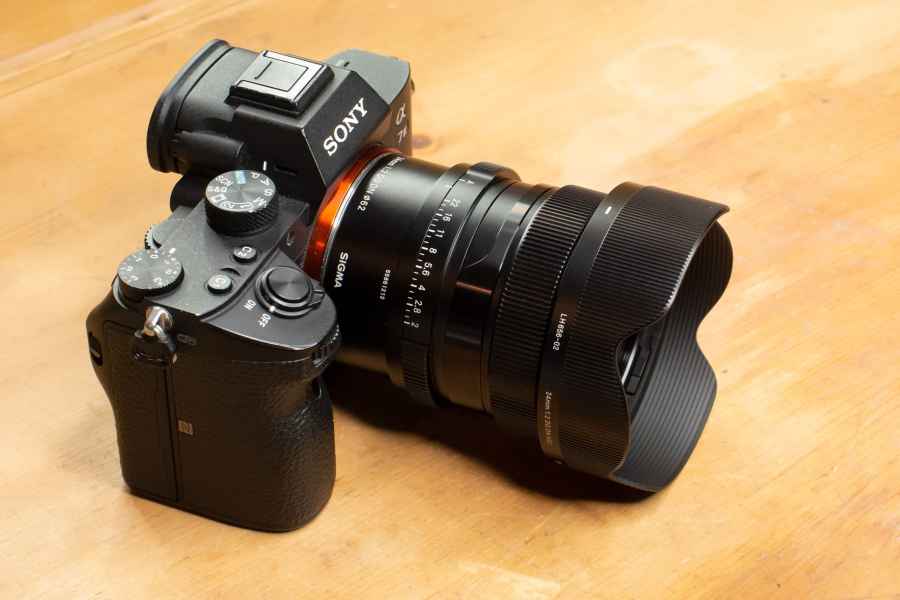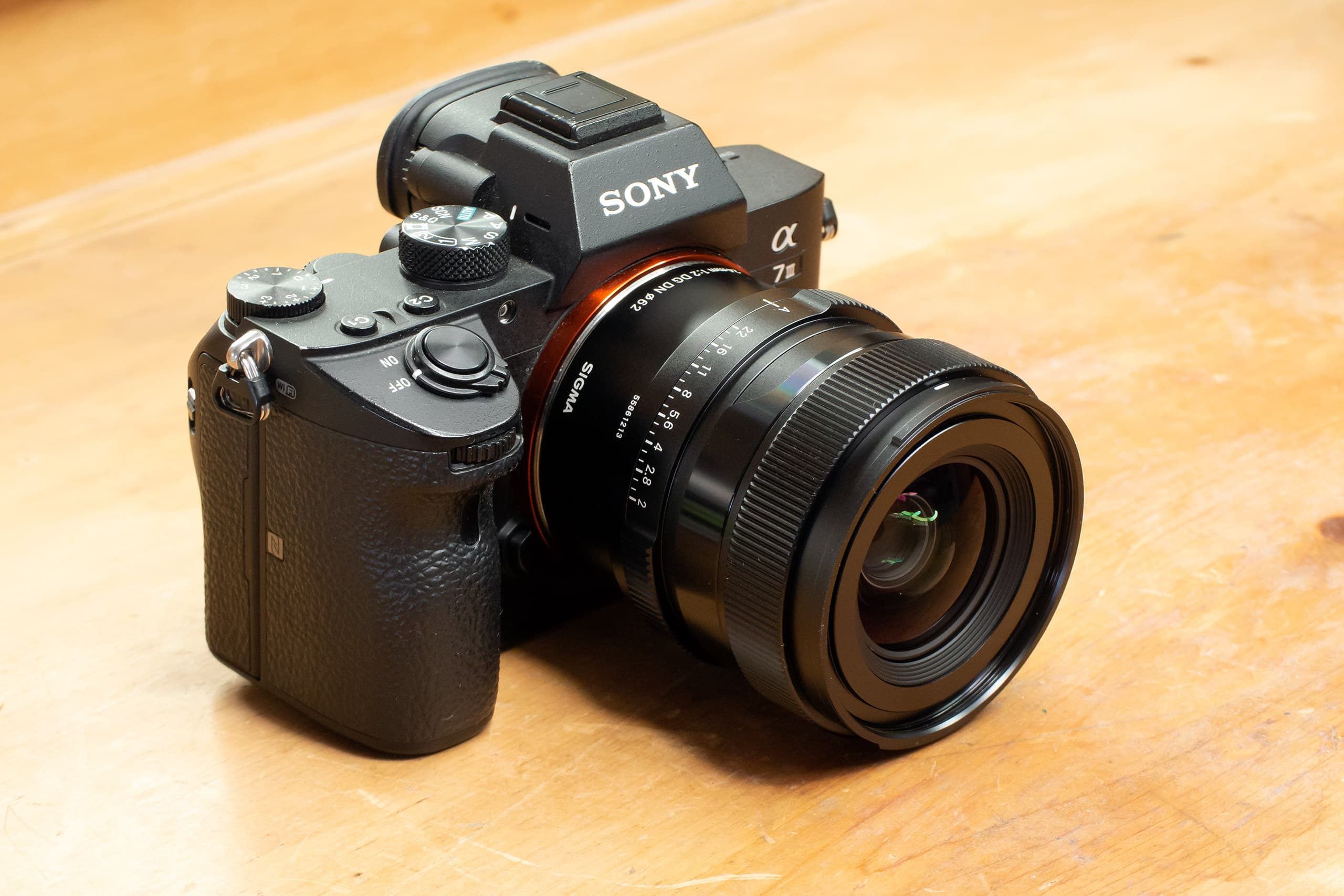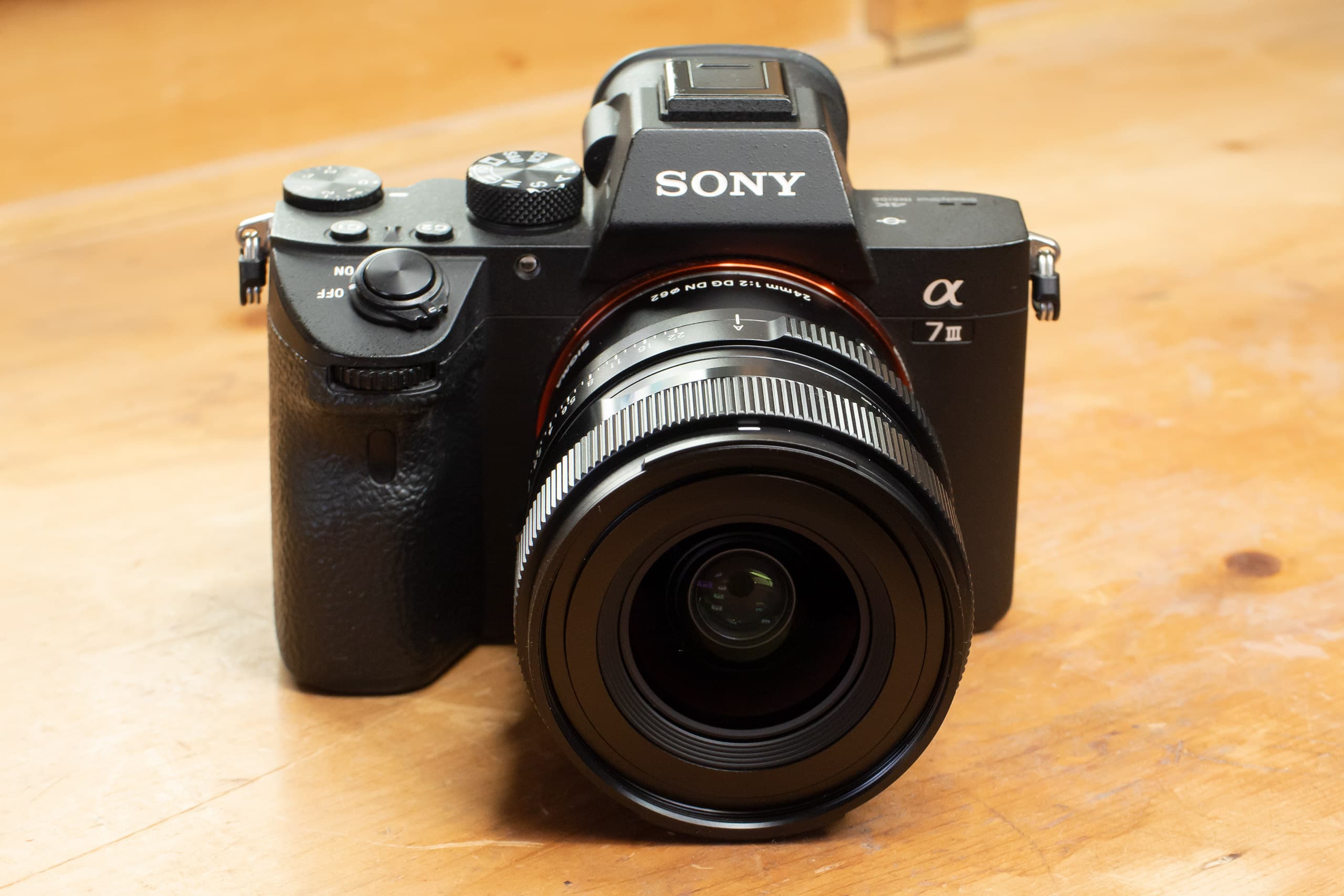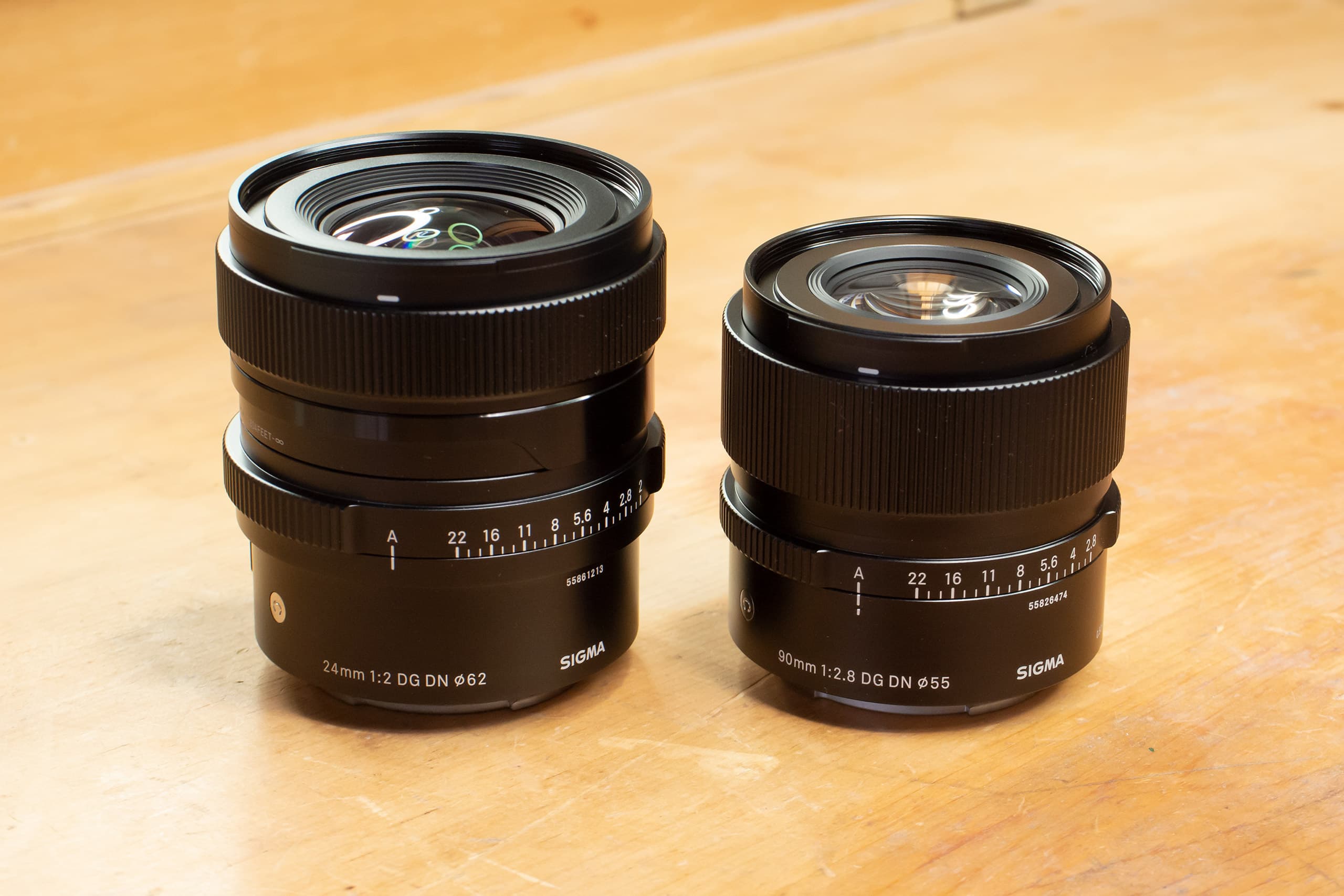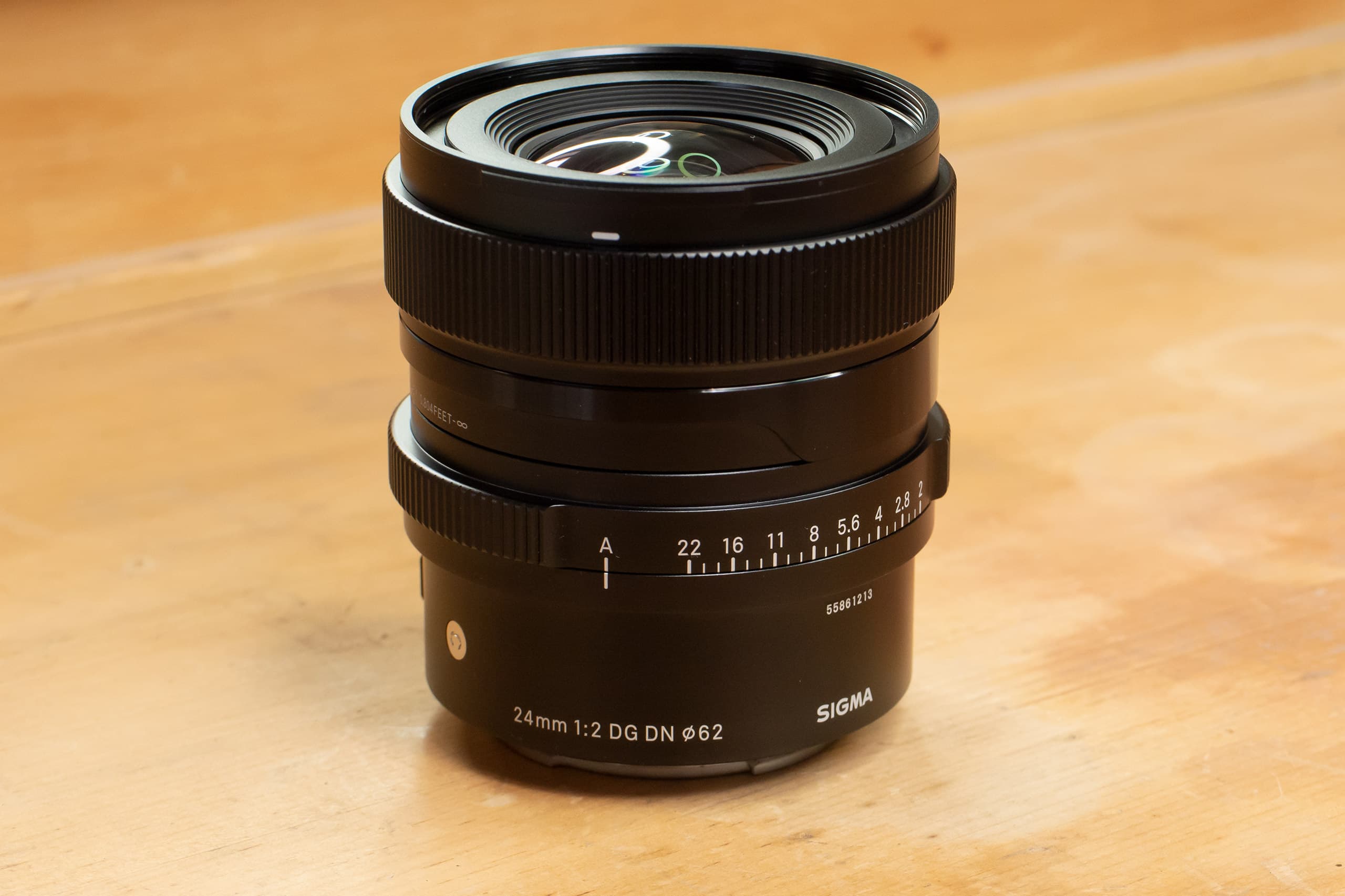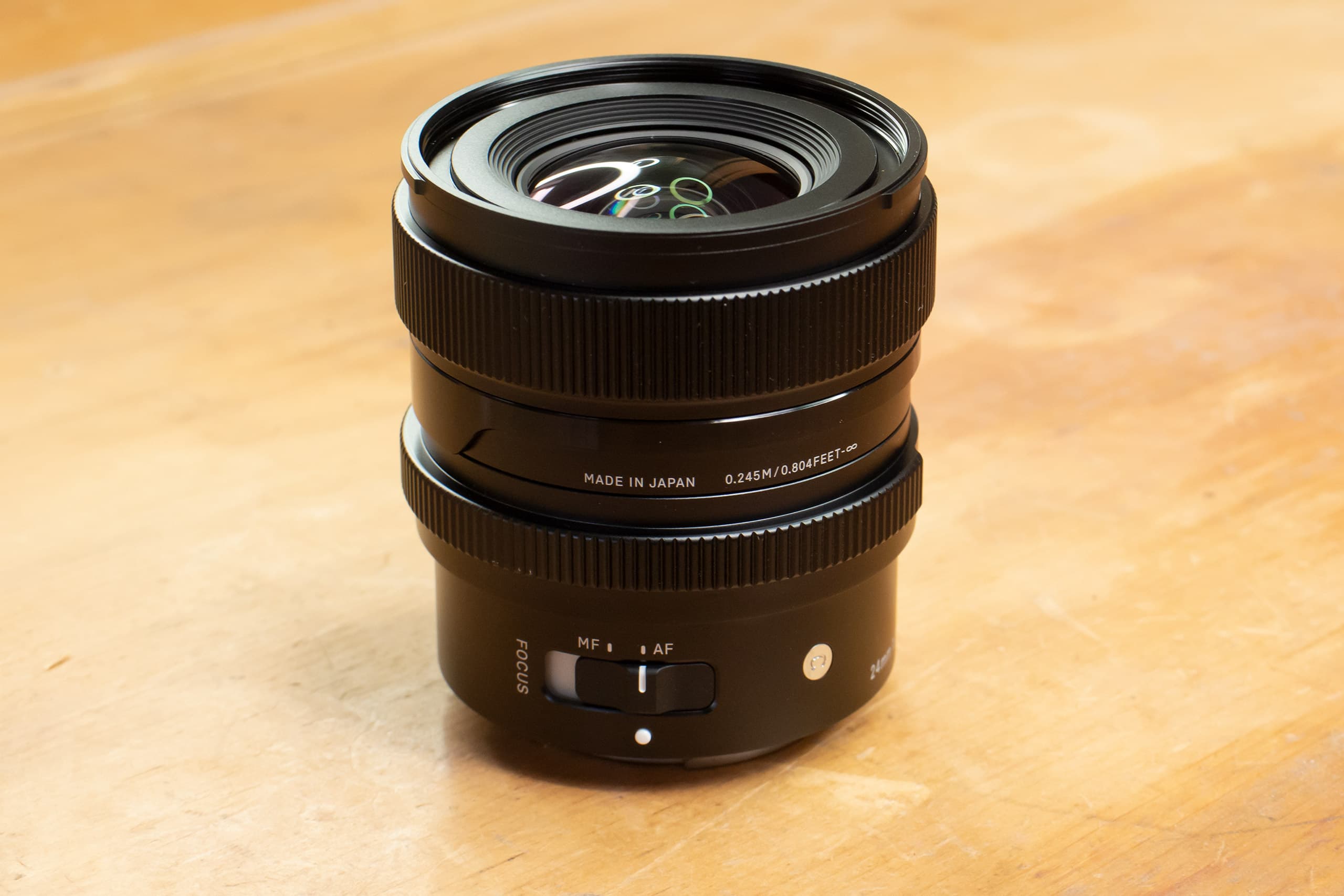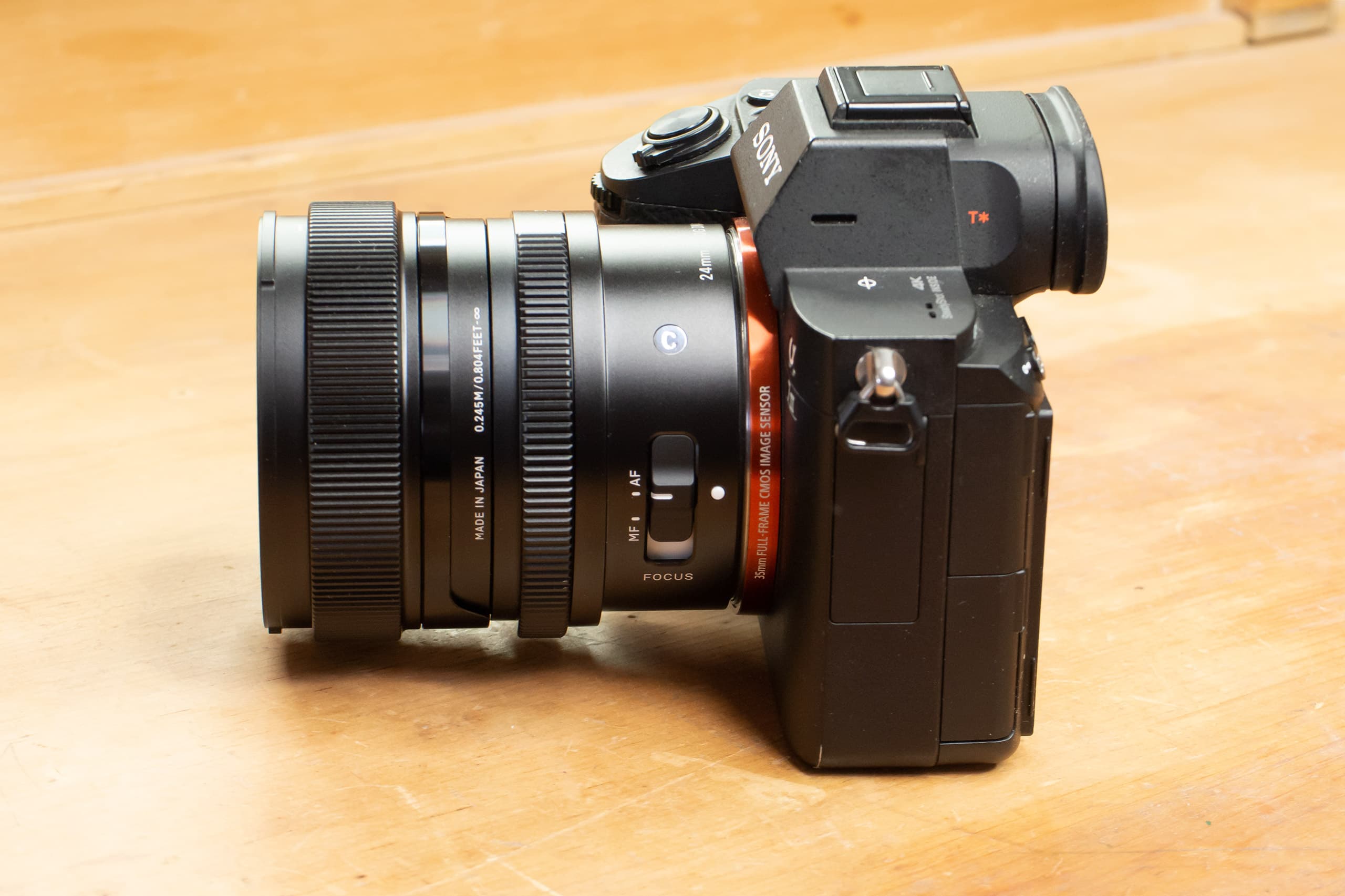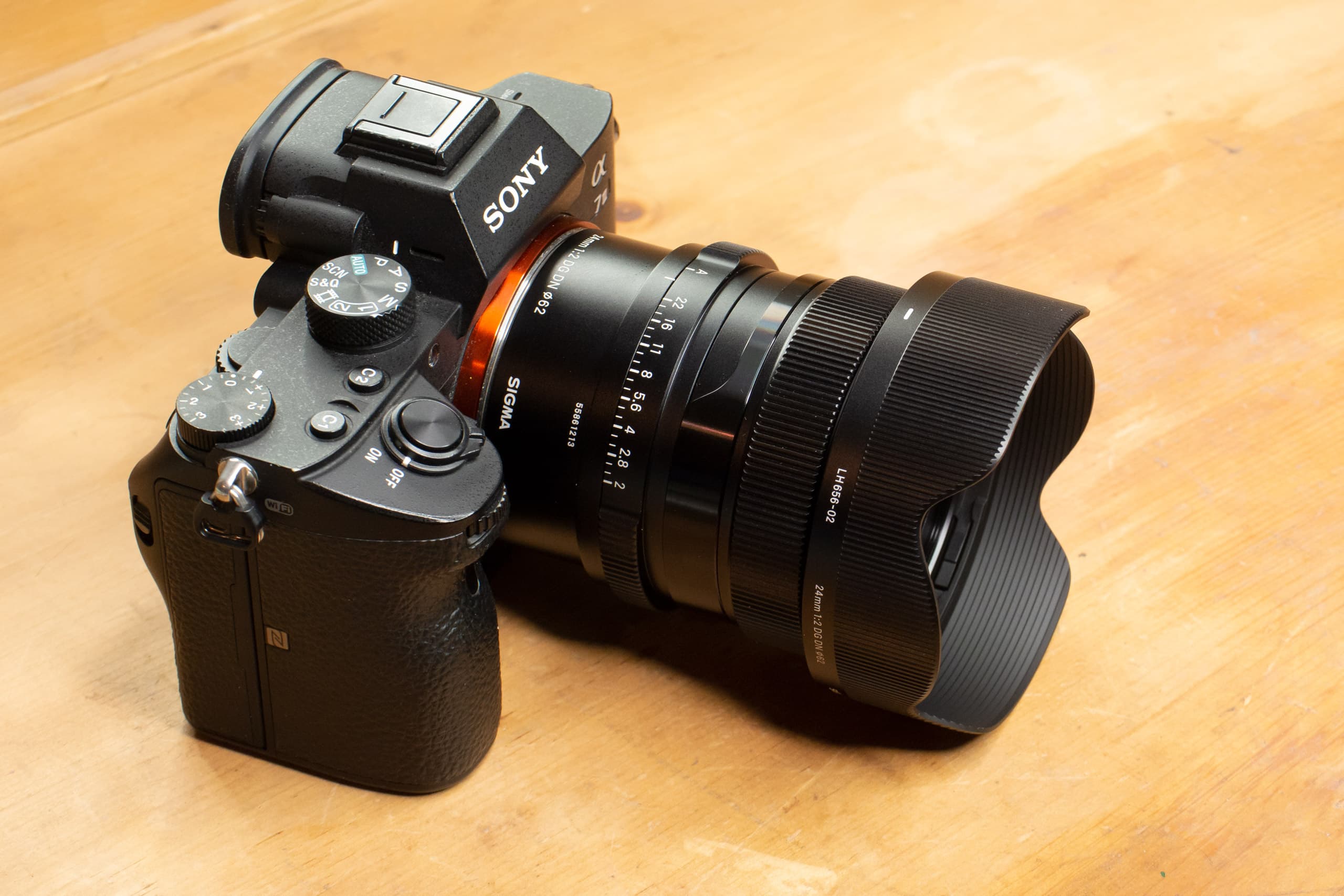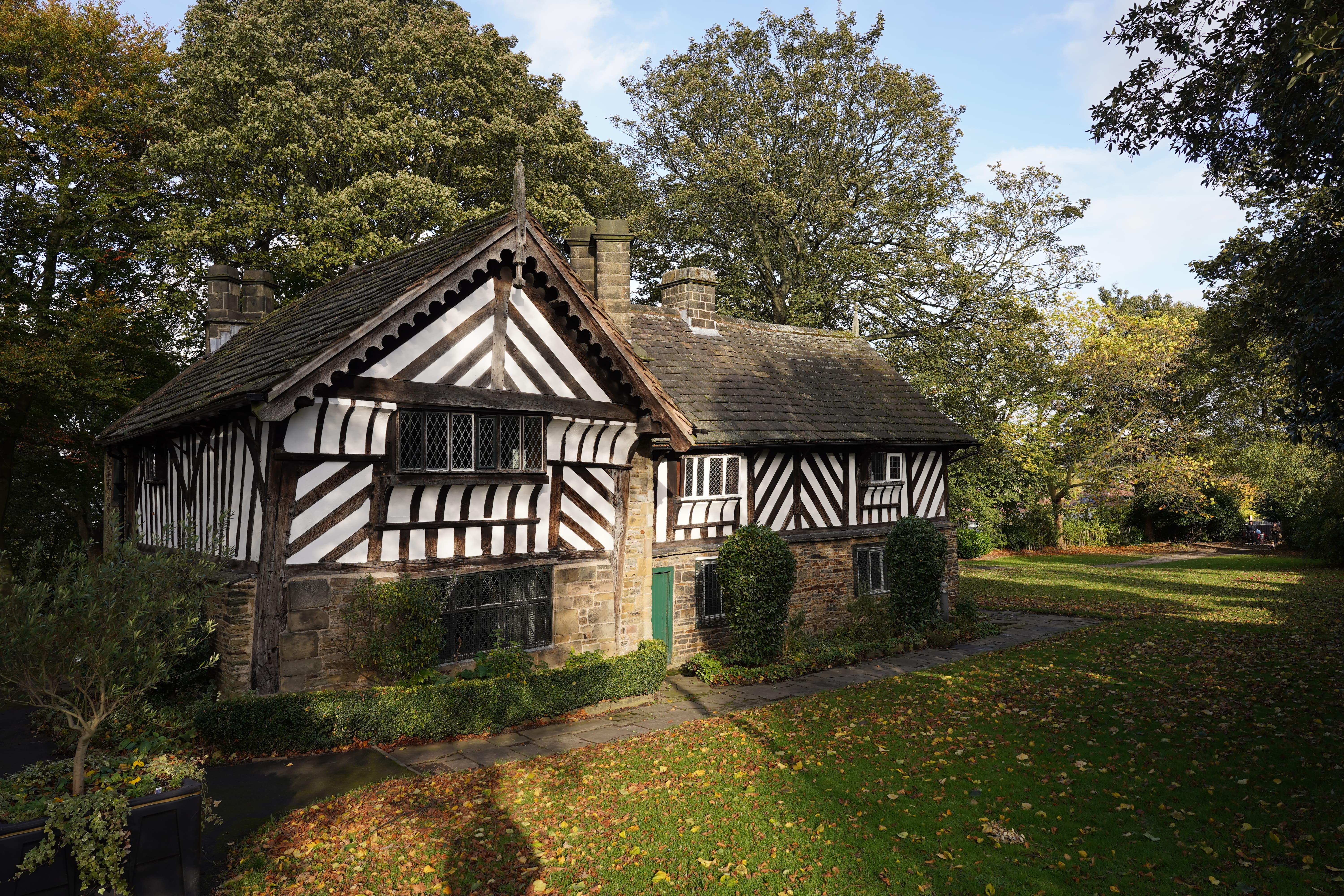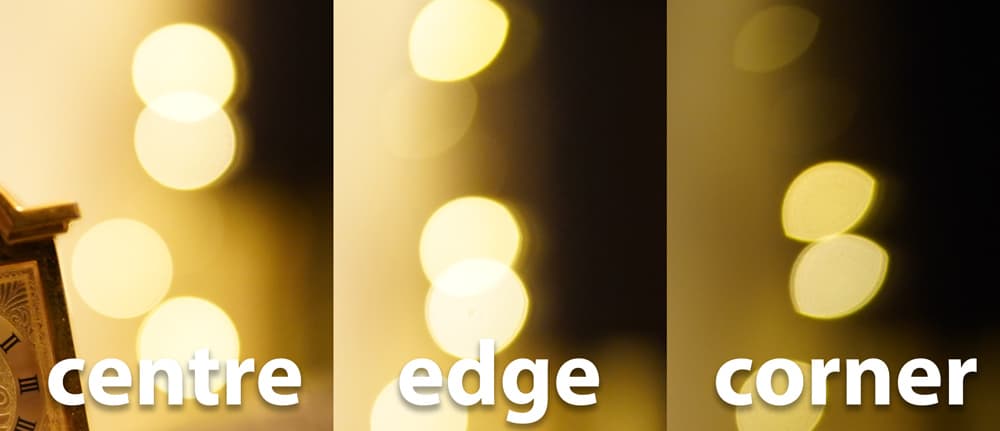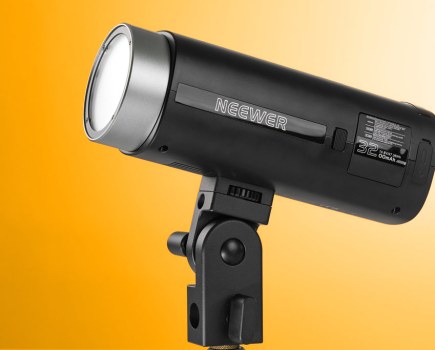Sigma has been on a bit of a roll recently, introducing a range of new, compact lenses for both L-Mount and E-Mount cameras. The wide-angle 24mm F2.0 DG DN Contemporary prime lens is one of the most recent lenses in the I series, and offers a relatively bright aperture for its size, whilst also being lightweight at 365g.
Sigma has now released a total of six I series lenses, which started with the 45mm F2.8 DG DN, a compact and lightweight lens that was released at the same time as the rather compact Sigma fp. As Sigma are part of the L-Mount alliance, this lens is available in L-Mount and E-Mount, designed for full-frame mirrorless cameras.
Sigma 24mm F2 DG DN Features
The Sigma 24mm F2 DG DN lens is part of the I series of full-frame prime lenses for mirrorless cameras, with E-Mount and L-Mount versions available. The lenses are part of a range of more compact lenses, made to match the more compact full-frame mirrorless cameras available, with cameras from Sigma, Panasonic coming in L-Mount, including the Sigma fp, and Panasonic Lumix S5, and Sony’s E-Mount cameras such as the Sony Alpha A7 IV, and Sony A7C.
Designed from the ground-up for full-frame mirrorless cameras, Sigma has been able to design a lens with optical correction where it is needed, for example, where optical issues can’t be corrected by software afterwards. And by correcting some of the optical issues in software, Sigma has been able to optimise the size. For example, correcting vignetting is an easy task for a camera’s built-in lens correction, and this has allowed them to make a smaller lens than they would have otherwise needed to produce.
The lens is designed to give high levels of optical performance, even when shooting at the maximum aperture of f/2.0.
OPTICAL CONSTRUCTION
The lens is made up of 13 elements in 11 groups, with 2x SLD elements, 1x FLD glass, and 2x aspherical lens elements. Sigma say this optical construction enables excellent correction of various aberrations, as well as suppressing sagittal coma flare, making it ideal for night sky photography.
There are 9 rounded diaphragm blades, which should give smooth round bokeh.
There’s a minimum focus distance of 24.5cm / 9.7inches, and the filter thread size is 62mm
The lens measures 70x74mm (E-Mount), or 70x72mm in L-Mount, with a weight of 360g in E-Mount, or 365g in L-Mount. This makes it suitably lightweight for smaller cameras as well as larger models. On the Sony Alpha A7 III, it feels like just the right size, being quite portable.
Like the other I series lenses, the build of the lens is an all-metal construction, with precision-cut aluminium, as well as a durable brass bayonet mount. This gives the lens a premium quality to it that goes beyond the “Contemporary” labelling. So, despite the “Contemporary” range being Sigma’s “entry-level” range, there’s nothing entry-level about this lens when it comes to build-quality, except for perhaps the lack of full weather-sealing.
Whilst the lens is not specifically weather-sealed, it can be considered “weather-resistant” with an oil and water resistant coating on the front of the lens, as well as a dust and splash resistant mount, thanks to there being a rubber seal on the rear.
The lens uses a high-speed stepping motor, which gives quiet, and fast AF performance.
The lens features Sigma’s Super Multi-layer coating to suppress flare and ghosting, preventing reflections within the lens.
There’s a solid metal ring for the aperture control, and this adds a nice level of manual control to the camera in comparison to the many lenses that don’t feature an aperture ring. The aperture ring gives you a range from f2.0 to f22, as well as an A/Auto position, with 2 stops in-between the main aperture settings. There is a stronger level of resistance between A and the aperture settings, to help you avoid accidentally switching between these. There is no clickless option.
The lens doesn’t feature optical image stabilisation, and therefore if you would like to have image stabilisation, you’ll need to ensure you pair the lens with a camera with in-body image stabilisation (IBIS).
In the box you get the choice of a standard lens cap, or the magnetic metal lens cap. You’ll also find a petal shaped lens hood, that is made out of metal. It’s also compatible with the Sigma USB Dock UD-11.
Sigma 24mm F2 DG DN Build and Handling
The metal lens is designed to be ergonomic, and for the most part it is, however, one thing I noticed was the somewhat angular nature of some of the edges. Whilst not sharp as such, they could be considered jarring if you’re being fussy.
In terms of ergonomics, the manual focus ring feels good, and there is a great level of grip on offer here.
The aperture ring has neatly designed ribbing for grip, with this raising up from a smooth surface at the edges of the labelling. The aperture ring features click stops, and there is no option to de-click the aperture ring.
Speaking of labelling, the printing on the lens is particularly impressive, being etched and painted rather than simply being painted or printed on, meaning that even with wear, the labelling should stay intact, and never rub off.
There’s a side AF/MF switch, letting you switch quickly between auto-focus and manual focus without having to use a function button or menu setting, and that’s it for switches. There are no function buttons.
The focus ring is very smooth in operation, with an electronic fly-by-wire design, with no stops, so that means once you’ve reached the focus limit, you can continue turning the focus ring and nothing happens.
A magnetic lens cap is provided in the box, as well as a standard plastic lens cap. This is a nice added bonus to find in the box, but if you’re planning on using a filter, then you’ll need to switch back to the standard plastic lens cap.
The lens is made of aluminium and has a good level of grip on the focus ring, and aperture ring, however, the ring in-between the aperture ring and camera is particularly smooth, and this can make attaching and removing the lens from the camera body particularly difficult, as there is very little grip provided. In fact, if you do try and use this area to remove the lens from the camera, you’ll find there’s simply not enough grip provided, unless you’ve been working on your Vulcan death pinch (that is to say you have to squeeze it very hard). With some practise this becomes easier.
On the Sony Alpha camera used the mount felt quite tight, adding to the difficulty attaching the lens. In the end, the easiest way to find some purchase (grip) onto the lens was to turn the aperture ring all the way until it stopped, and then use that as the grip when attaching or removing the lens.
The lens hood fits neatly onto the lens, and is also made of metal, which is quite rare, for an “entry-level” lens, and it’s event rare on some premium lenses from other manufacturers. The inner section of the hood is made of plastic, and the hood will fit the standard way, as expected, as well as reversed, should you wish, although this does block the focus ring.
Weighing 360g the lens feels like a good weight, not too light to suggest low quality, with enough heft to feel like a solid lens, but not too much to make it feel heavy when paired with a mid-size full-frame camera, such as the Sony Alpha 7 III.
Autofocus
The lens gives relatively rapid focus with no noticeable lack in performance, even when shooting in low-light conditions. The only delay that was noticed was in very dark conditions, or when using the lens at the closest focus distance.

Focus performs well even in low-light, Sheffield christmas lights, 24mm, 1/160s, f/2, ISO640, Sony A7 III
Switching to manual focus and there is a smooth action to the focus ring, with plenty of travel available for fine tuning focus as needed. Turn the focus ring slowly to focus more precisely or turn it more quickly to travel more quickly through the focus range.
Sigma 24mm F2 DG DN Image Quality
The lens is designed to give high levels of sharpness, and certainly the lens delivers plenty of sharpness and detail. Sharpness is very good at f2.0 particularly in the centre of the frame, but the corners are not as sharp as the centre, until you stop down slightly.
The image does become sharper when stopped down, with peak levels of sharpness appearing between f4 and f5.6, where levels of sharpness across the frame are excellent, and this extends into the corners which also improve.
When needed, you can shoot wide open and get the benefits of a sharp image, as well as good looking background blur (aka bokeh). There is circular “bokeh” in the centre of the image, but these become more like cats-eyes towards the corner of the frame. If you’re being very fussy, and have slightly underexposed the shot, then the middle of these do show an element of “onion” rings, but this is very minimal, and depends where they are in the frame, and it is not as pronounced as on some lenses. However, you don’t normally buy a 24mm lens to spend hours photographing bokeh balls, so really this should be somewhat of a non-issue, especially as it’s so minimal.
Whilst you can focus on a subject as close as 24.5cm, you’ll need to stop down to get the best results, as the shallow depth of field at f/2.0 is very apparent.
The camera’s built-in chromatic aberration correction takes care of any purple fringing or chromatic aberration, and even with this switched off, it was difficult to spot any major issues.
Vignetting is noticeable when viewing uncorrected images, and could be considered quite strong when shooting wide-open, however, this lens is designed to be used with vignetting (shading) correction switched on, and therefore isn’t something to be concerned about. If you are concerned, then vignetting is mostly gone by f/3.2.
Similarly, if you view the uncorrected images, then there is a high level of barrel distortion visible. However, the lens is designed to be used with lens distortion correction switched on at all times, so this shouldn’t be an issue.
Flare resistance is quite impressive, with some flare visible only when shooting with a very bright light in the frame (such as the sun), and even then, the effect can be controlled depending on where the light source is in the frame. If you’re looking to use a lens for creative flare, then you’re unlikely to find it with modern lenses.
Sun stars and light points in the image will give you a star with 18 points.
Alternatives available
The Sigma 24mm F1.4 DG HSM Art for Canon EF / Nikon F cameras, weighs in at 665g, which goes to show how much lighter the 24mm F2 lens is, at 365g. It’s also more expensive at £699, compared to the 24mm F2 at £549.
The Sigma faces stiff competition from the cheaper, and slightly brighter Samyang AF 24mm F1.8 FE lens priced at £459, but offers very good value for money compared to the Sony FE 24mm F1.4 G Master lens priced at £1450.
There are a couple of small 24mm lenses available, including the Samyang AF 24mm f2.8 FE (£279), and for those who want something even smaller, there is the Sigma 24mm F3.5 DG DN C lens (at £479).
Sigma 24mm F2 DG DN Verdict
Whilst the Sigma 24mm F2.0 DG DN is not as affordable as some of the alternatives available, the build quality and design of the lens are something that is clearly justified. With this lens you’re buying a high-quality lens that should last several cameras, and beyond.
Image quality delivers the goods with high image quality, with excellent levels of sharpness. Sigma set out to design a lens that could be both compact, and deliver high levels of image quality, and they have certainly delivered. Whilst there is vignetting in uncorrected images, this is part of the design philosophy, being easily corrected in software, and enabling a more compact lens.
The build quality is admirable, and certainly gives the lens a premium feel, with much higher than expected build quality. The relatively compact size of the lens and the bright aperture make this a lens you can easily take with you without worrying about size and weight.
The aperture ring and AF/MF switch give the lens a more tactile feel, and for those that wish to use manual controls, these will be a welcome addition. They add to the premium feel of this lens, which considering the “Contemporary” labelling, is an unexpected bonus.


